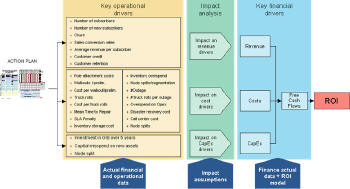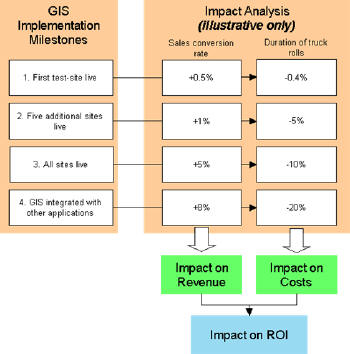How can the advocates of GIS demonstrate the return on investment (ROI) to the top management team and ensure that the benefits are realized through implementation?
Through our experience designing strategic GIS programs for clients, we have developed a value-driven framework that has allowed our clients to demonstrate the ROI and derive benefits realization from GIS and related technologies. Our methodology, which is completely independent of technology choice, includes these following key steps, which are further described below:
- Identify GIS benefits collectively
- Build a bottom-up ROI model linking operational drivers and financial benefits
- Link the ROI model to the delivery roadmap
When identifying GIS benefits, it is critical to emphasize the collective nature of the exercise. Going through this as a group, including not only engineers and operators but also business and financial managers, is crucial to building consensus around the benefits of the implementation of GIS. Although the key output of the exercise is a document linking the business objectives with GIS benefits, it's more about the "journey" than the "destination."
The first thing that the group should do is to agree on the objectives and requirements for both the organization and the individual departments; these should be expressed in business or operational terms. For instance, in the case of one of our clients, a large broadband cable operator, the field operations department claimed that a GIS solution would reduce the number of site visits required during the sales process because of access to better and integrated documentation. Plus, when a site visit was still required, the time required per visit would be reduced.
These operational benefits can be linked to financial benefits, and we will see how in the following sections. At the same time, our client's sales organization claimed that by better targeting prospects close to or on the existing network, their sales force would be able to sell more effectively. The engineering department said that the consequence of targeting prospects close to or on the network would be to reduce the average capital expenditure required to build out to the new customers. These GIS benefits would not only trigger cost savings but could also be directly linked to sales and market share growth through sales conversion.
The team now has two sets of data: one set of goals and objectives, and one set of potential benefits. For this particular client we identified more than 25 potential areas of benefit, covering operational cost savings, revenue growth and capital expense reduction.
This set of goals and benefits provides the organization and the GIS implementation team with:
- A breakdown of the GIS strategic plan into manageable components or objectives (expressed as potential benefits)
- A clear allocation of the benefits across the organization to reinforce ownership and commitment
- An effective communication tool across divisions and functions
- The basis for a solid ROI model and business case
After building consensus on the benefits and objectives with the multi-disciplinary team, the challenge is then to quantify the identified GIS benefits from a financial perspective.
The potential GIS benefits are far-reaching and are generally more visible for those closer to the technology than to others. To counter this reality, the team must identify the key operational performance metrics related to the benefits identified in the initial step. In essence, this means converting the business stated benefit to financial measurement language. For example, using our broadband cable operator client, when the sales organization says that GIS will increase sales effectiveness, it should attempt to quantify how the sales conversion rate will be affected, that is, how many additional prospects will each sales representative convert each month? Likewise, the engineering department should try to estimate by how much the number of site visits would be reduced, as well as the reduction in the average duration of the site visits. All these estimates provided by operational, marketing and financial staff form the base upon which the ROI model is built.
One benefit of this bottom-up approach is that key business and function experts get involved in the ROI assessment process earlier and therefore own the assumptions within the financial model. Given the large number of assumptions, it is essential to link each assumption to a key owner or stakeholder. This allows the GIS team to create robust foundations for the business case.
After documenting all key assumptions, the challenge for the team is to link these to financial performance indicators, such as revenue, cost and capital expenditure. The idea is to be able to draw a link from an operational performance indicator to the ROI generated by GIS, as demonstrated in Figure 1. For instance, going back to the sales conversion rate benefit, by linking the increase in the conversion rate to the number of potential customers and average sales per sales rep, the financial manager can estimate the increase in revenue (and impact on ROI) generated by the implementation of GIS. Likewise, using the engineers' reduction in site visits and site visit duration, the financial manager can link these to the hourly cost of each site visit and estimate the potential cost savings for that specific operational benefit. Again, that cost savings directly impacts the ROI.
 |
Finally, with all assumptions from business and functional experts collected and linked in one single repository, the ROI model, the finance team can estimate the potential financial value to be delivered by GIS. The credibility of the exercise is reinforced by the fact that operational staff from across the business each provides feed into the model. With so many benefits identified, the overall case becomes much stronger because no single benefit is of the "make-or-break" variety. Also, in our experience, many of the benefits can actually be "toned down" to very credible levels acceptable by the business, with the collective contribution still giving a very attractive ROI.
The final ROI model provides a framework to:
- Prioritize the key GIS value drivers, that is, which affected operational value drivers are key for GIS to deliver its benefits
- Test implementation scenarios
- Provide financial estimates for the budget or finance teams
- Validate the financial estimates for each operational value driver with business managers (making the estimates very robust at the individual level)
- Easily extrapolate to other parts of the network if only partially completed.
Link the ROI model to the delivery roadmap and organization
The next challenge for the team is to ensure that the operational and financial benefits are realized according to the plan. The team must develop a Benefits Delivery Roadmap, phasing the delivery of the various benefit components. In combination with the ROI model, the team can then monitor the delivery of the GIS benefits and review the benefits on a regular basis, if needed.
To facilitate the process of benefits realization, the ROI model can help the team prioritize the activities by performing a sensitivity analysis on the key operational performance indicators, especially those with a high degree of uncertainty. For instance, returning to the sales conversion rate example, we found this particular metric had a strong impact on the ROI and required further analysis to narrow down the range of revenue-driven benefits to be realized. On the other hand, the sensitivity analysis showed that some operational performance indicators had little impact on the ROI and therefore did not require further analysis or assumption validation. The sensitivity analysis allowed the team to allocate their time in accordance with the weight of each assumption on the ROI itself.
This sensitivity analysis also enabled the team to select the top five to eight metrics that contribute most to the ROI - these metrics must be tracked and reported by the implementation team. Through the process of identifying benefits, the existing situation will be captured and the benefit itself defines the potential future end-state. Implementation milestones can be linked to discrete incremental benefits along the way, and the improvements predicted and ultimately tracked by the project.
Thus the ROI model can be turned into a monitoring and tracking tool to assess the progress made against the various operational factors, but also against financial metrics. Thanks to the granularity of the information provided by the ROI model, the team can accurately pinpoint the key savings and revenue generation benefits created by GIS, as illustrated in Figure 2. By this stage, the team can easily convince the rest of the organization of the benefits of GIS, with each discussion and debate contributing to refining the assumptions and reinforcing the credibility and robustness of the analysis.
 |
Like any major system implementation, GIS implementation programs come under scrutiny from the finance department, shareholders and the top management of the organization. Too often, large system implementation projects can be stopped dead in their tracks as their initial advocates or sponsors struggle to demonstrate the link between operational and financial benefits. Without an ROI model, the top management can only focus on how much GIS costs and not how much it yields. ROI modeling provides an effective framework to identify, measure and track GIS-specific benefits from an operational and also financial perspective. It also provides the top management with a clear view on the subsequent benefits to come, preventing a premature end to the implementation of GIS projects.